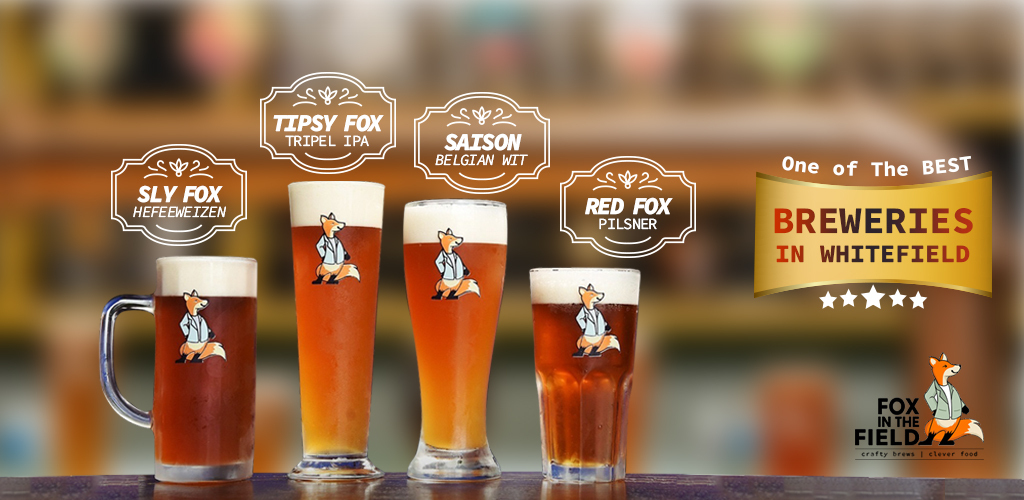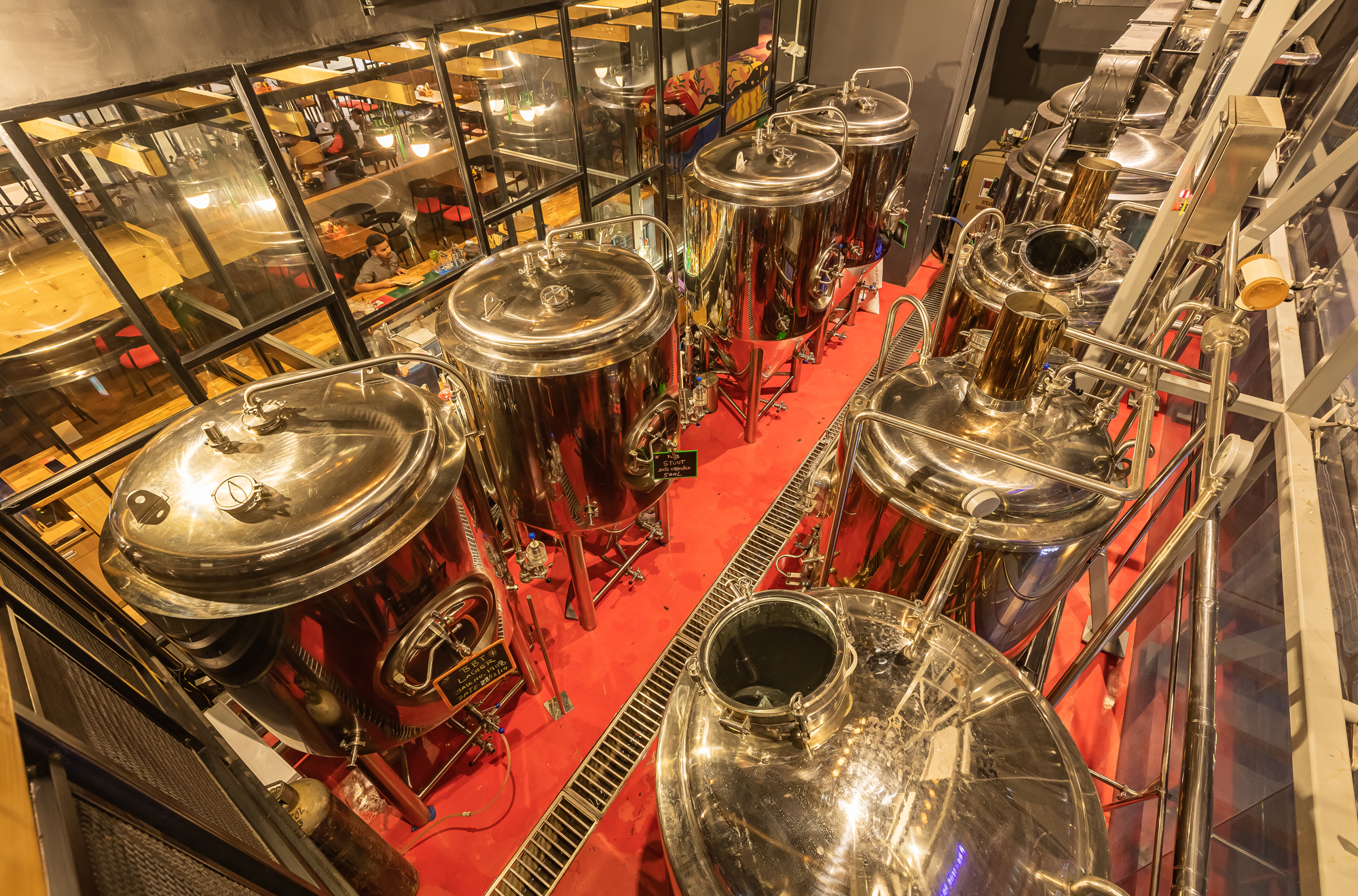Fox Beer

- SLY FOX (HEFEEWEIZEN)
A German Hefeweizen relatively low on bitterness, with notes of light biscuit, caramel and some fruity esters.

- TIPSY FOX (TRIPEL IPA)
A fusion-blending high strength and complexity of a Triple, made with the Belgian Triple yeast & IPA. It is a heavily hopped, fruity and bitter beer.

- SAISON (BELGIAN WIT)
Saison, a slightly sour beer produced with a spontaneous fermentation is usually considered the Champagne of the beer world. It is a light bodied, refreshing, high carbonated beer.

- RED FOX (PILSNER)
A staple of English Country side, Larger is the no. 1 beer in the UK. We use fragrant spiced English hops to flavor this subtle and refreshing beer.

THE BREWING PROCESS

MALTED BARLEY
To begin, the brewer makes malted barley out of barley husks. To make the malt, the
barley is immersed in water, where it germinates, or sprouts. The sprouted barley is then
dried in a kiln. Within wide time and temperature variations, the creation of many
different malts is possible, from the pale malts of pilsners to the roasty malts of stouts and
porters—and everything in between.
MILL
A mill cracks open the malted barley kernels with steel rollers, exposing the starches
inside. Starches convert to sugar and later convert to alcohol. We call these broken kernels
“grist.”
MASH TUN
Next, the grist goes into the mash tun, where hot water is added to make “mash” with a
porridge-like consistency. In about an hour, the hot water has acted as a catalyst to
convert starches to sugars. The result is called the wort, a mixture of barley husks and
sweet liquid. It’s also known as sweet wort, because bittering hops haven’t yet been
added. Once the desired wort is arrived upon, the temperature is jacked up to 170
degrees, ending the conversion of starches to sugars completely. The result is a wort that
is less viscous and easier to separate from the mash. This is what’s known as mashing
out.
LAUTER TUN
The lauter tun acts like a big sieve, separating the barley kernels from the liquid
that will become beer. To increase the level of filtration, some of the first wort to
be separated may be put back through a second time. This is known as
recirculation. Additional water may also be added in a process called “sparging”.
BREW KETTLE
The wort is collected from the lauter tun and is transferred to the brew kettle. The
brewer checks to make sure that the sugar concentration is at the desired level. It’s
measured as a sugar percentage by weight, and is known as the original gravity of
the wort. The wort is boiled, and then hops are added. The boiling does three
things: first, it sterilizes the wort so that later, when yeast is added, the yeast is the
only microorganism in the wort. Second, it extracts the bitterness from the hops,
flavoring the beer to the brewer’s design. Lastly, it coagulates malt proteins so that
they can be skimmed out along with the hops. After the first round of hops,
additional hops can be added. The hops added later are typically for aroma, as
these hops are not in the kettle long enough for the aromatics to be boiled away.
WHIRLPOOL
With the hops now added to the wort, it’s now called “bitter wort.” And the hops and
proteins need to be skimmed off. Here, a whirlpool action draws all solid matter to the
center of the tank and the wort can be drained off from the edges.
HEAT EXCHANGER
Active temperature management is a key consideration for the brewer. At this point in
the fermentation process, the wort needs to be cooled. If cooled too slowly, unwanted
chemicals can be released in the wort and you run the risk of microbial contamination.
So a heat exchanger is used to cool the wort down fast. Once the wort is sufficiently
cooled (40-45°F for a lager, and above 55°F for an ale), it’s added to fermentation tanks,
where the yeast is introduced.
FERMENTATION
This is primary fermentation. The fermentation tanks mark the only time oxygen is
freely introduced and in contact with the liquid. Aerating with oxygen helps the yeast
split into multiple cells. Once the oxygen is depleted, the yeast reacts by consuming the
glucose, maltose, and maltotriose (sugars). The reaction of the yeast causes the
temperature of the liquid to rise and brewers watch this closely, taking cooling
measures as needed. The liquid needs to stay at an acceptable temperature range for the specific beer being brewed. The wort can now be called beer!
FILTRATION
Fresh out of the fermentation tank, as you can imagine, the beer is full of yeast and
particulate matter. When these are strained out here, rendering it a clear liquid, it’s referred to as “bright beer.” But here again, the brewer must take care to not filter out what makes this beer style what it is. The correct colour and flavours must be preserved. Some brewers surpass the sterile filtering by pasteurizing their beer, getting it just hot enough to kill the yeast and any other bacteria.
LAGERING
This process is considered the secondary fermentation. Once the beer is at the desired
gravity, it’s cooled and conditioned in a bright beer tank. Here, the flavour is refined.
Ales take less time, lagers take longer and are conditioned at lower temperatures that
are near freezing.